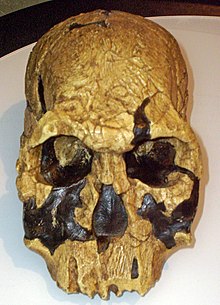H. rudolfensis
|
Homo rudolfensis Temporal range: , 1.9 Ma |
|
|---|---|
 |
|
| Reconstruction of the KNM ER 1470 skull | |
| Scientific classification | |
| Kingdom: | Animalia |
| Phylum: | Chordata |
| Class: | Mammalia |
| Order: | Primates |
| Family: | Hominidae |
| Genus: | Homo(?) |
| Species: | H. rudolfensis |
| Binomial name | |
|
†Pithecanthropus rudolfensis Alekseyev, 1978 |
|
Homo rudolfensis (also Australopithecus rudolfensis) is an extinct species of the Hominini tribe known only through a handful of representative fossils, the first of which was discovered by Bernard Ngeneo, a member of a team led by anthropologist Richard Leakey and zoologist Meave Leakey in 1972, at Koobi Fora on the east side of Lake Rudolf (now Lake Turkana) in Kenya.
The scientific name Pithecanthropus rudolfensis was proposed in 1978 by V. P. Alekseyev who later (1986) changed it to Homo rudolfensis for the specimen Skull 1470 (KNM ER 1470). It remains an open question whether the fossil evidence is sufficient for postulating a separate species, and if so whether this species should be classified as within the Homo or Australopithecus genus.
On 8 August 2012, a team led by Meave Leakey announced the discovery of a face and two jawbones belonging to H. rudolfensis.
The fossil KNM-ER 1470 was the center of much debate concerning its species. The skull was at first incorrectly dated at nearly three million years old, predating the Homo habilis species. Since then, the estimate has been corrected to 1.9 million years, but the differences in this skull, when compared to others of the Homo habilis species, are said to be too pronounced, leading to the presumption of a Homo rudolfensis species, contemporary with Homo habilis. It is not certain whether H. rudolfensis, H. habilis or some, as of yet undiscovered, third species was ancestral to the later Homo line.
In March 2007, a team led by Timothy Bromage, an anthropologist at New York University, reconstructed the skull of KNM-ER 1470. The new construction looked very ape-like (possibly due to an exaggerated rotation of the skull) and the cranial capacity based on the new construction was reported to be downsized from 752 cm³ to about 526 cm³, although this seemed to be a matter of some controversy. Bromage said his team's reconstruction included biological knowledge not known at the time of the skull's discovery, of the precise relationship between the sizes of eyes, ears, and mouth in mammals. A newer publication by Bromage has since increased the cranial capacity estimate back up, from 526 cm³ to 700 cm³.
...
Wikipedia
